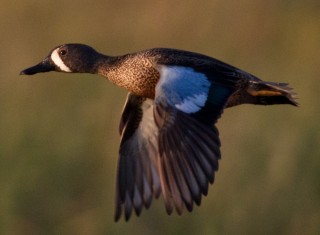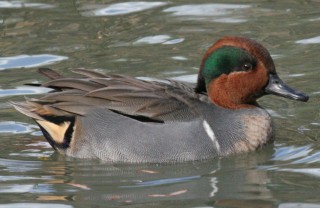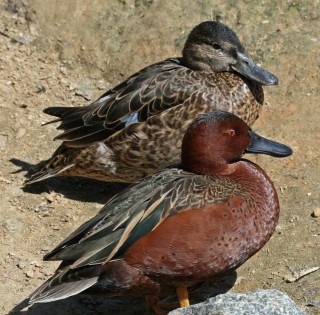
Blue-winged Teal are one of the first ducks to migrate south in the fall, arriving in Texas in August and appearing in large numbers by September. Blue-winged Teal are tiny dabbling ducks that feed in the top few inches of water. Drake teal are more strikingly patterned than females. Wikimedia Commons Photo.
South Texas is blessed with a slew of wintering waterfowl. Small ponds, lakes, bays, marshes, and even the surf host over 25 species of ducks. Open fields are sometimes white with large flocks of geese. Even the occasional swan can be observed in Texas. Migratory waterfowl breed as far north as the Arctic Circle. Fortunately, many of these birds have the good sense to winter in Texas.
There are two main groups of ducks: the dabblers and the divers. The dabblers are generally smaller and they can take off from the water surface directly, without running. Divers are heavy-bodied ducks that prefer deeper water. A diving duck usually has to run along the surface of the water before becoming airborne.
Dabbling ducks rarely dive (although they can) and prefer to feed by dabbling their bills in the water. Their food is primarily pondweeds, algae, and small invertebrates. Dabblers are also called “tip-up” ducks because some of the species lean forward completely submerging their heads with their feet in the air. Since tip-up ducks feed in the top few inches of water, they are found in smaller, shallower bodies of water.
As the name suggests, diving ducks dive underwater in search of food. They can go down several feet to the bottom to feed on aquatic plants’ leaves, stems and bulbs. Wild celery is a favorite of many of these species. They also take tadpoles, frogs and even small fish, as well as many invertebrates.

Green-winged Teal are the smallest North American dabbling ducks and one of the most attractive. They are a favorite with hunters. This duck is second only to Mallard in numbers harvested annually. Male Green-winged Teal sport shiny red-brown heads with a green streak around the eye. Wikimedia Commons Photo.
Ducks arrive in our area throughout the fall. The earliest is the Blue-winged Teal, a warmth-loving dabbler. Blue-winged Teal can be found on South Texas ponds as early as September. Its relatives, the Green-winged Teal and Cinnamon Teal, take a more leisurely approach to migrating. These two teal species sometimes don’t show up until November.
Teal are lovely little ducks. Although the females of all three species resemble each other, the males are strikingly colored and patterned. A drake Blue-winged Teal has the chalky blue wing patch and a bold white crescent on his cheek. Green-winged Teal drakes have a beautiful red-brown head with a sleek green streak around their eyes. And male Cinnamon Teal are almost totally a shiny cinnamon color. While Blue-winged and Green-winged Teal are pretty common, you have to be especially lucky to see a Cinnamon Teal.
The three teal species are our smallest ducks. Teal typically weigh less than a pound. But that is a very succulent pound of duck. Teal are primarily vegetarians and their flesh is never fishy tasting. Most duck-hunters agree that you should cook duck only to 170 degrees, which means it is eaten rare. Overcooked duck is said to taste like liver.

Cinnamon Teal are among the smaller North American dabbling ducks. While the male is a striking cinnamon color, the female is rather drab and brown. In fact, the females of all three teal species look very much alike. Cinnamon Teal are uncommon and somewhat local winter residents along the Texas coast from early September to late May. Wikimedia Commons Photo.
There is a special “teal only” season in September. For two weeks starting on September 13th this year, hunters were able to go after teal, mostly Blue-winged Teal, the early migrants.
Regular duck season opens in South Texas on November 1, 2014. Youth Only Hunting is on October 25-26, 2014. All hunters are required to have a valid hunting license and to purchase a Texas Migratory Game Bird Stamp. Youth (17 years and younger) do not need the stamp.
Go out now and look for the arriving ducks. It takes practice to identify ducks, especially at a distance. Take some time on one of these lovely fall afternoons and find a pond with several birds on it. Examine the ducks carefully. Use a spotting scope if you have one. Hopefully, you will see all three teal and several other species as well. Happy duck season!
ESSAY BY KAREN L. P. BENSON
If you would like to receive Karen’s Nature Essays by email, please signup here.
